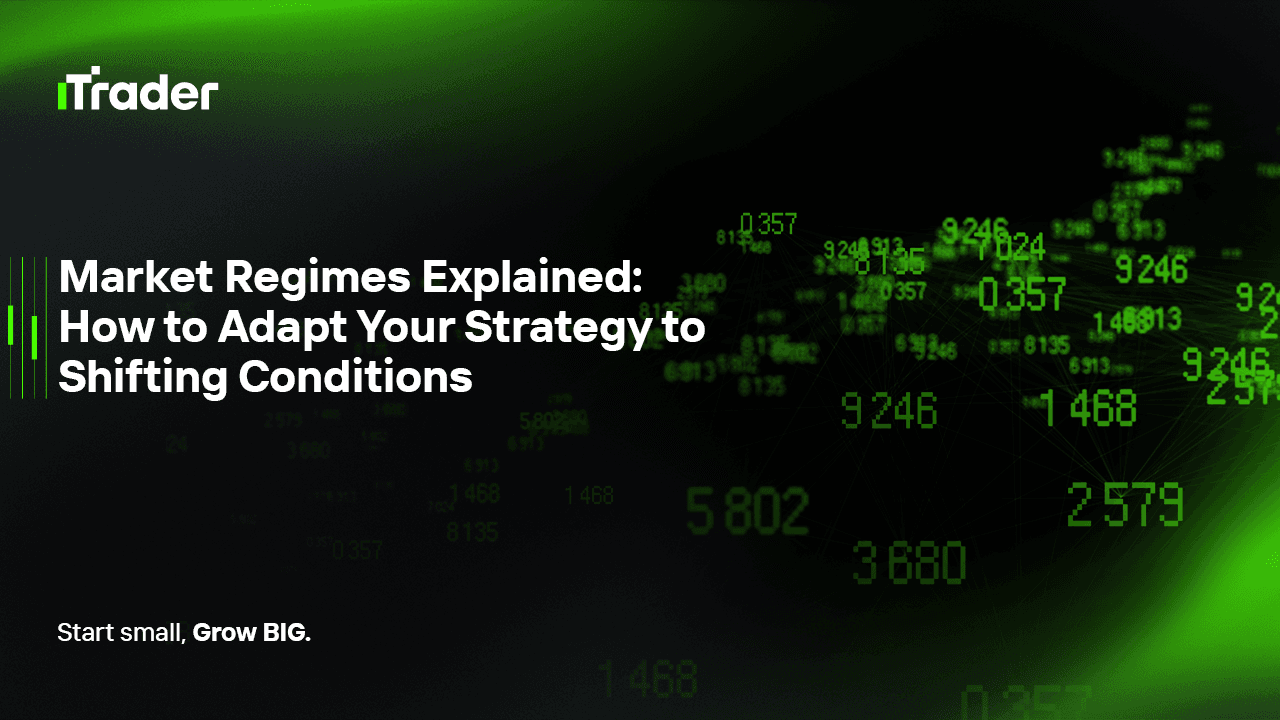2025-09-29
In the Forex market, stable and predictable environments are rare. Exchange rates can fluctuate sharply over short periods, while at other times, they may stagnate without any clear direction. In some phases, macroeconomic factors dominate price action; in others, technical dynamics take the lead. All of this directly affects the performance of trading strategies: what works well in one environment may underperform or even fail in another.

For prop traders, understanding market regimes and adjusting strategies accordingly is not merely a question of profit maximization. It’s a critical factor in passing evaluations, managing drawdowns, and securing funding.
This blog explores what market regimes are, how to identify them, how to adjust strategies when conditions shift, and why this adaptive ability is essential in a prop trading environment.
A market regime refers to the dominant structural and behavioral characteristics of the market over a specific period. Each trading strategy tends to perform best under a particular set of conditions. When the regime changes, performance deterioration is common if the strategy is not adapted accordingly.
Market regimes can be categorized in various ways, but the most common classifications are based on four main dimensions:
Identifying the prevailing regime provides the foundation for deciding which strategies to deploy, how to size positions, and when to stand aside.
Market regimes should not be identified by intuition alone. Using objective metrics allows traders to systematically classify conditions and adjust accordingly. The following are commonly used tools.
Rising volatility often calls for smaller position sizing or wider stop placement to avoid unnecessary whipsaws.
Most strategies are overfitted to a particular environment during backtesting. Parameter settings that work well in one regime often break down when conditions shift. This leads to several common issues:
When regimes shift, traders should not blindly abandon their systems. Instead, they should apply structured adaptation methods, including rule-based adjustments, volatility-sensitive sizing, filtering, or switching between strategy clusters.
This involves setting clear, objective rules for determining the current regime and activating specific strategies accordingly. For example:
This approach provides a systematic way to align strategies with prevailing conditions.
Adjusting position size according to volatility is one of the most effective ways to control drawdowns. By linking position size to ATR or historical volatility, traders can reduce risk during turbulent periods and scale up during stable phases.
This involves running multiple strategies in parallel and dynamically allocating capital based on regime. For example:
More advanced methods include:
These approaches enable a higher degree of automation in adapting strategies to changing environments.
Theory alone is not enough. To benefit from regime analysis, traders must integrate it into their daily and systematic processes.
Keep a daily log that maps observed market regimes to strategy performance. Over time, this creates a clear picture of which strategies work best in which conditions. It also improves your situational awareness as a trader.
Instead of relying on static backtests, use Walk-Forward Analysis to periodically re-optimize strategy parameters on rolling windows. This reduces overfitting and maintains alignment with current market regimes.
Monitor regime indicators in real time and adjust position sizing, entry filters, or strategy activation accordingly. For prop traders, this is essential to staying within daily and overall drawdown limits.
Prop firms evaluate traders primarily on consistency and risk control. Many traders fail evaluations not because their strategies are bad, but because they don’t adapt when market conditions change.
A trader with strong regime adaptation capabilities can:
In short, regime adaptation transforms a trader from someone who merely “has a good strategy” into someone who can survive, adapt, and thrive in any market.
Market regimes represent the underlying structure of price behavior. Ignoring them and applying a fixed strategy mechanically leads to performance decay, drawdowns, and potential funding failures.
Traders who use objective regime identification metrics and implement systematic adjustments—through rule-based switching, volatility-sensitive sizing, strategy stacking, or machine learning—gain a critical advantage. They:
Strategy ≠ Success.
Strategy × Market Regime Alignment = Sustainable Performance.
2025 Ай Трейдер Глобал ХХК | Компанийн бүртгэлийн дугаар: 15962
Ай Трейдер Глобал ХХК нь Комор улсын Анжуан арал дахь Мутсамуду хотын Хамчакод байрлалтай. Тус компани нь Коморын Үнэт Цаасны Хорооноос (Securities Commission of the Comoros) олгосон L15962/ITGL дугаартай тусгай зөвшөөрлийн хүрээнд үйл ажиллагаа явуулдаг.
Ай Трейдер Глобал ХХК нь “iTrader” нэрийн дор үйл ажиллагаа явуулдаг бөгөөд (Форекс) арилжааны үйл ажиллагаа явуулах эрхтэй. Компанийн лого, барааны тэмдэг, вэбсайт нь зөвхөн Ай Трейдер Глобал ХХК компанийн өмч юм.
Ай Трейдер Глобал ХХК -ийн охин компани болох : iTrader Global Pty Ltd, Австралийн компанийн бүртгэлийн дугаар (ACN): 686 857 198. Энэ компани нь Opheleo Holdings Pty Ltd компанийн албан ёсны төлөөлөгч бөгөөд Австралийн санхүүгийн үйлчилгээний төлөөлөгчийн дугаар: 001315037 -тай. Австралийн санхүүгийн үйлчилгээний лицензийн дугаар: 000224485 -тай Level 1, 256 Rundle St, Adelaide, SA 5000 хаягт байршдаг. Анхааруулга: Энэ байгууллага нь энэхүү вэбсайт дээр болон дамжуулан арилжаалагдаж буй санхүүгийн (арилжааны) хэрэгсэл нийлүүлэгч биш бөгөөд ямар нэгэн хариуцлага хүлээхгүй болно.
Эрсдэлийн сэрэмжлүүлэг: CFD арилжааны хөшүүргийн улмаас хөрөнгөө хурдан алдах өндөр эрсдэлтэй тул бүх хэрэглэгчдэд тохиромжгүй байдаг.
Фанд, CFD болон бусад өндөр xөшүүрэгтэй арилжаа нь хэрэглэгчээс нарийн төвөгтэй ойлголтуудын талаар тусгай мэдлэг шаарддаг. Хөшүүрэгтэй арилжаанд оролцогчдын 84.01% нь алдагдал хүлээдгийг судалгаанууд харуулдаг тул хөшүүрэгтэй арилжаанд орохоос өмнө хөрөнгөө алдах маш өндөр эрсдэлтэй болохыг анхаарна уу.
iTrader нь аливаа иргэн, хуулийн этгээдийн өмнө xөшүүрэгтэй арилжааны эрсдэл, алдагдал, бусад хохирлыг бүхэлд нь хариуцахгүй болохыг мэдэгдэж байна.
Энэхүү веб сайтын мэдээ, мэдээлэл нь зөвхөн мэдлэг түгээх зорилготой тул хэрэглэгч та бие даан шийдвэр гаргана уу.
Хязгаарлалт: iTrader нь вэбсайт болон үйлчилгээгээ тухайн орны хууль тогтоомж, дүрэм журмаар хориглосон орнуудад оршин суугчдад чиглүүлдэггүй. Хэрэв та энэхүү вэбсайтыг ашиглахыг хориглосон оронд байгаа бол вэбсайт болон үйлчилгээг ашиглахдаа тухайн орны хууль тогтоомжид нийцэж байгаа эсэхийг шалгах үүрэгтэй. iTrader нь вэбсайтынхаа мэдээлэл бүх оронд тохиромжтой эсэхийг баталгаажуулдаггүй.
Ай Трейдер Глобал ХХК нь зарим улс орны иргэдэд үйлчилгээ үзүүлэхээс татгалздаг болно. Жишээлбэл: АНУ, Орос, Бразил, Канада, Израйл, Иран.